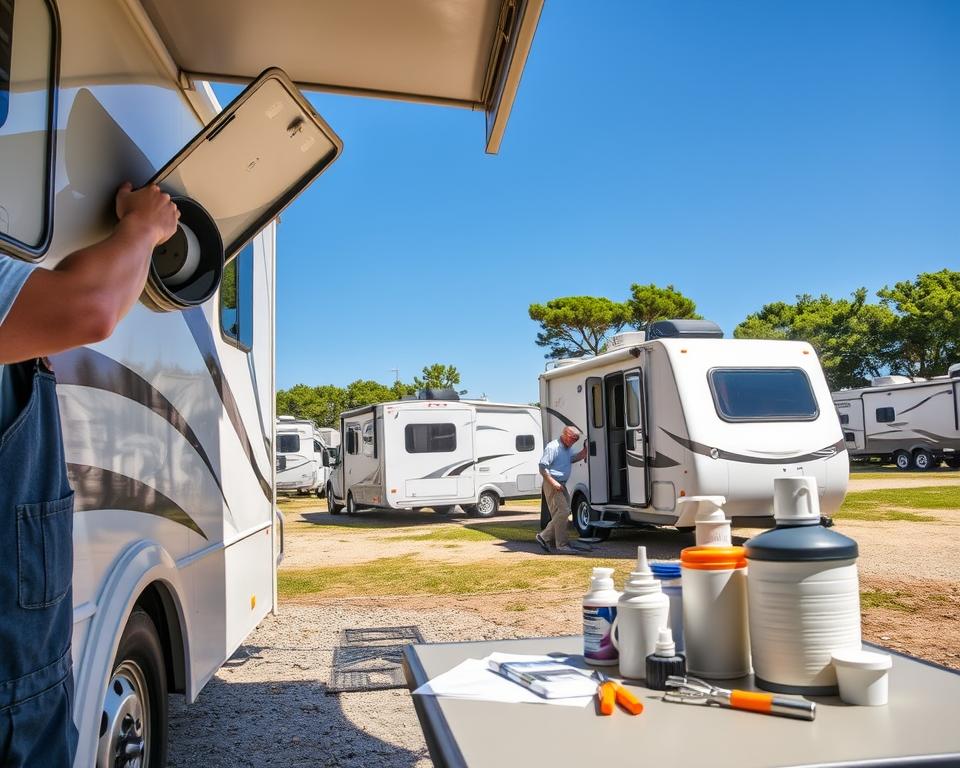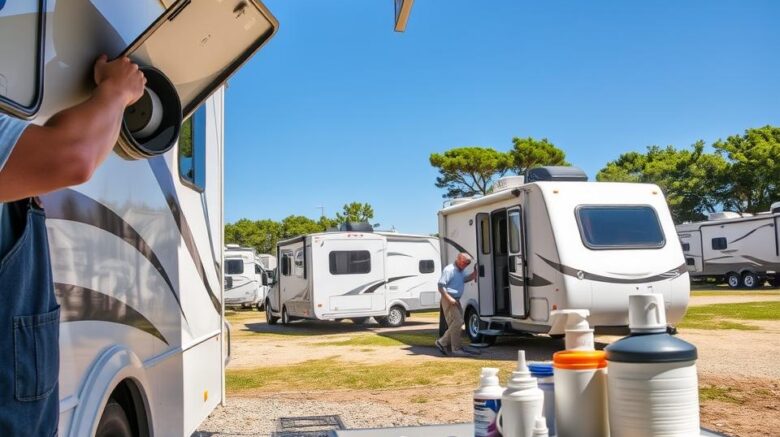RV Sewer Pump Guide: Key Maintenance Advice
Did you ever ponder the operation of your camper’s waste disposal system? Knowing the ins and outs of your RV sewer pump can avoid mishaps, enhancing your outdoor adventures. It’s about managing waste productively and steering clear of unpleasant aromas. With this manual, you’ll discover key maintenance techniques for RV septic service near me. Every tip is intended to preserve your sewage system’s optimal function.
Learning About Your RV Sewage Pump Network
The recreational vehicle waste pump network is vital for waste management, making camping more comfortable. It features two primary tanks: the black water tank for bowel output and the grey-water reservoir for water from sinks and showers. Distinguishing between these tanks is key to avoid clogs and keep your RV running seamlessly.
An camper macerator unit is a widely used solution for refuse disposal. It pulverizes solid waste into small fragments, streamlining disposal. In contrast, a traditional camper sewage pump is available. It competently moves waste without pulverizing, for those seeking a simpler option.
Understanding your RV’s sewage pumping system is vital to warding off problems and ensuring smooth examinations. Using the system effectively can prevent messes, enhancing your outdoor adventures.
Value of Regular Service
Caring for your RV waste pump is crucial for a trouble-free journey. Without proper maintenance, you may face odors, clogs, or backups. These glitches can wreck your road trips.
Scheduled upkeep thwart such issues and extend your system’s life. By reviewing hoses and seals, you maximize efficiency. A properly cared-for RV sewage pump guarantees hygienic operation, letting you enjoy continuous journeys.
Regular servicing also yields financial savings over time. Lack of care can cause costly breakdowns, requiring expensive replacements. Backing regular maintenance keeps your motorhome in prime shape, preserving money long term.
When to Empty Your RV Septic Tank?
Understanding when to empty your RV Septic Tank is vital for its upkeep. It’s suggested to pump every three to five days during use. For brief excursions, post-trip emptying may suffice.
Frequency depends on different variables. Tank capacity and frequency of use are critical. Best practice is to pump when it reaches two-thirds full. This helps support steady waste movement and avoid clogs.
Checking your RV Septic tank capacity is key for a stress-free outing. Ensure proper management of your camper’s effluent to avoid issues while traveling.

Optimal Methods for Tank Disposal
Properly emptying RV tanks is essential for your motorhome’s cleanliness and reliability. Begin with the black water tank to let the grey water rinse leftover solids. This technique ward off clogs and ensures uninterrupted discharge.
Opt for a top-grade drain hose for disposal. A heavy-duty hose avoids leaks and locks connections. Add a tank rinser for a complete flush, using water pressure to remove remaining debris, boosting cleanliness.
Comprehensive emptying prevents residue buildup, stopping foul odors and potential issues. To maintain an optimal sewage system in your motorhome, observe these guidelines:
- Always add a tank treatment after emptying to manage smells and decompose waste.
- Watch capacity to avoid overflow situations.
- Perform routine pump inspections for clogs and wear.
- Perform a deep tank flush every 4–8 weeks, even during less frequent trips.
Implementing these practices enhances your sewage system’s lifespan and efficiency, ensuring pleasant trips.
Avoiding Foul Odors and Clogs
For a memorable adventure, keeping odors at bay is crucial. Keep enough water in tanks to aid in breaking down waste, stopping unpleasant odors. Also, opting for RV-approved tissue helps prevent clogs, avoiding backups.
For enhanced refuse control in campers, try bio-agent additives. These process sludge thoroughly, easing upkeep. Check the vent line often to keep air moving freely in the plumbing system.
Mindful disposal is crucial to avoiding tank issues. Refrain from disposing of wipes, feminine products, and paper towels. These non-biodegradable items can cause serious blockages. Following these tips helps maintain a cleaner camping environment.
Maintenance Advice for RV Sewage Pumps
Maintaining your RV’s sewer pump system is key for hassle-free trips. Check valve seal integrity often to prevent leaks. Faulty seals can cause unwanted leaks, harming your RV.
To banish smells and maintain cleanliness, sanitizing is essential. Do thorough sanitation regularly to avoid deposits, ensuring the system functions optimally. These steps are imperative for maintaining a mobile macerator, promoting longevity and smooth service.
Oiling valve mechanisms is another essential task. It helps avoid drips and boost functionality. Monitoring tank sensors is key for exact data, preventing overflows and unexpected pump issues. Regularly reviewing these points makes your RV adventures more sanitary and more enjoyable.
Signs You Might Need a Professional Pump-Out
Spotting sewage issues early can ward off major issues. A primary clue you need a professional pump-out is slow draining. When sinks and toilets take longer to clear, it often points to blockages. It suggests your system may be full.
Ongoing foul scents are another distinct indicator of sewage troubles. Unpleasant fumes hanging around despite cleaning suggest trapped waste. It’s crucial to inspect the clear elbow attachment when dumping waste. Visible residue signals it’s time for pro maintenance.
Technicians utilize jet machines to blast through tough clogs efficiently. Ignoring these warnings can lead to major problems. Therefore, it’s essential to seek help immediately when issues arise.
| Warning Signs of Waste Problems | Recommended Response |
|---|---|
| Delayed Drainage | Check obstructions; call expert service |
| Ongoing Foul Scents | Check vents; contact pro service |
| Remaining Sludge | Contact pump service for thorough cleaning |
Choosing the Right RV Macerator Pump
When picking an RV macerator pump, assess its volume handling, durability, and compatibility with your RV’s size. A reliable macerator is key for effective waste grinding. This is especially important for RVs requiring frequent disposals. High-end pumps enhance sewage handling, ensuring a smoother RV lifestyle.
Different models cater to varied requirements. For an well-founded selection, focus on these essential considerations:
- Capacity: Confirm volume capability suits your needs.
- Durability: Choose pumps with robust construction.
- Ease of Use: Select pumps with intuitive controls.
- Compatibility: Confirm it matches your fittings.
Taking time to compare when choosing an RV macerator pump improves travel enjoyment and ensures proper sewage disposal.
RV Sewer Pump Problem-Solving
Effective problem-solving for your RV sewer pump is key in resolving common sewage issues before they worsen. If you notice sluggish emptying, unexpected backups, or persistent odors, take immediate action. These are obvious indicators of malfunction requiring attention.
Begin by examining the pump, its connections, and hoses. Look for any clogs that could slow flow. Ensure inlet and outlet fittings are properly connected. Also, verify the pump’s power supply for reliable current.
If basic checks don’t uncover the issue, listen to the pump’s sound. A unit that’s abnormally loud or too quiet may have internal damage. Also, inspect for leaks, as these can magnify sewage problems. With these troubleshooting steps, many RV owners can find and fix issues early, avoiding costly repairs.
Extended RV Pump Upkeep
For lasting performance, dedicate yourself to regular sewer pump upkeep. Sanitize the system consistently to prevent clogs. Implement and follow a maintenance routine, keeping everyone informed of their roles. This markedly boosts your waste system’s lifespan.
Educating yourself and others on proper waste disposal is vital. This forestalls issues and fosters shared responsibility. The result benefits both users and the sewer system.
- Routine inspection of hoses and connections
- Maintain clear filter screens
- Arrange yearly pro maintenance
- Apply recommended conditioners
Sticking to these steps enhances your camper’s sewage system’s durability and keeps it effective, making travels more enjoyable.
Conclusion
Maintaining your camper’s waste pump properly is key for smooth camping adventures. Regular attention to RV sewer system maintenance drastically lowers problem risks, letting you immerse in the journey. By knowing your system and using reliable sewage methods, your trips will be free of waste management woes.
Applying the essential tips from this guide promotes RV waste management and improves your travel comfort and safety. Maintain peak performance by following best upkeep practices and addressing potential issues promptly.
Staying vigilant about your RV sewer system is rewarding. It provides homely comforts while exploring. Cheers to joyous and carefree journeys!
Common Queries
How can I tell it’s time to empty my RV Septic tank?
Pump the RV Septic tank when it hits 66% capacity.
What’s the difference between the black tank and the grey tank?
Black tank is for sewage waste. On the other hand, the grey tank collects water from sinks and showers.
When to service my RV sewer pump?
Inspect and sanitize system about every three months.
Recommended products for RV sewer pump maintenance?
Use enzyme-based treatments safe for RVs.
What prevents blockages in RV plumbing?
Avoid flushing non-biodegradable items.
What signs indicate I need professional RV pump-out?
Watch for slow drainage, recurring odors, or visible residue in the elbow.
Tips to optimize camper macerator performance?
Ensure capacity and compatibility.
Key inspection points for a thorough RV sewer cleanse?
Clean sensors and lubricate valves.
Maintaining my RV sewer system over time?
Adopt regular deep cleans and consistent sanitation.
Septic pumping frequency for heavy RV use?
Schedule pump-outs every 3–5 days.
